Paramecia
General information
Paramecia (= paramecia) are members of the ciliates or ciliates, which unfortunately also include such pests as the pathogens that cause Ichthyophthirius multifiliis or the species of the genus Helicostoma, which cause RTN (Rapid Tissue Necrosis) in corals.
They are very large for unicellular organisms and can be recognised with the naked eye as small, white, elongated dots. For very small fry, paramecia may be too large as a first food - although they are a good third smaller than Artemia nauplii - and you will then need smaller infusoria, such as certain rotifers.


Feeding
Feeding with coffee cream works well (Aldi coffee cream/portion jars have proven reproducible, other brands usually work just as well, but this must be checked in each individual case). Only add a few drops (in a well-populated batch approx. 4 - 5 drops daily for a 1 litre container, otherwise less) to a batch so that a slight cloudiness remains. Only when the mixture is clear again is it fed again. Adding a small piece of dried banana peel from time to time has also proved to be a good idea.
These preparations can easily last for 2 - 3 months, after which a portion must be removed and a new culture started. If you regularly remove liquid and refill with clear water, the cultures will remain productive for much longer thanks to this "water change".
The paramecia can be cleaned for feeding by sealing some of the culture in a test tube with a cotton plug and covering it with clear aquarium water. Due to the developing lack of oxygen, the paramecia work their way up through the stopper and can be removed cleanly with a syringe. However, this is not necessary for most fry, except for a few exceptions, which can be fed directly from the clear solution.
The paramecia we propagate probably belong to the species Paramecium caudatum, as this species is best adapted to the conditions in the breeding tank. In nature, these conditions are most likely to be found in heavily organically polluted waters such as cesspools or sewage treatment plants.

